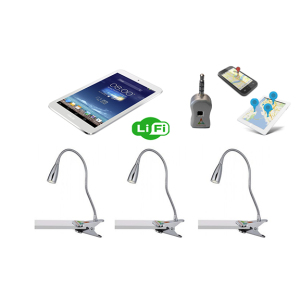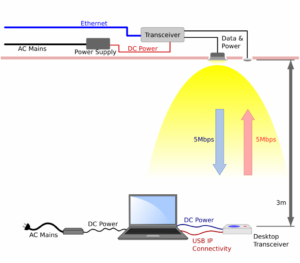We recently saw a news item stating that Yuyang D&U has started to commercialise Li-Fi and we thought it might be useful to give a bit of background on the technology. Yuyang has a deal with LG Innotek to develop the concept.
Li-Fi is optical networking* and exploits the fact that LEDs are semiconductors and can switch with the speed of chips. As a result, very high data rates can be transmitted using the modulation of LEDs. The idea seems to have got its name in 2011 after a Ted talk when Harald Haas (involved with PureLiFi of Scotland) pointed out that there are 14 billion light bulbs in the world that can be replaced by LEDs to deliver networking. Of course, this means that the LED has to be emitting light, but this could be at a level that is low enough that the LED might not appear to be on.
Li Fi system overview 1024×898 – Source PureLiFi
One of the appealing aspects of the technology is that detectors might be as simple as the cameras in your smartphones. There are also some features that are useful in some applications. For example, radio waves used for Wi-Fi go through walls, but light doesn’t which means that a light-based network can be secure in a room if the light can’t escape.
Light also might be a good solution in areas where radio waves are not desirable – such as networks in chemical plants, medical environments or in aircraft. Further, with LED lights being used in automotive lighting applications, Li-Fi might be a very good way to communicate between cars and trucks (and what about using LED traffic lights to signal to approaching vehicles?)
Embedding Li-Fi into lamps can also be used for “geo fencing”. Devices can be set up so that while they are in a particular physical space, and exposed to light from a particular lamp, then they are “OK”, but generate an alarm if they are moved out of the area.
We spoke to PureLiFi at the MWC event in February 2014 and at the time, the firm told us that it had pushed performance up to 10 Mbits/sec using lighting LEDs, but that it could get much further – potentially up to 10.5Gbps by exploiting the idea that if you use RGB LEDs, you could modulate each colour separately and the limit looks like 3.5Gbps for each colour.
The Fraunhofer IPMS in Germany has been working in this area for some time (it was a founder of the Li-Fi Consortium) and at Electronica 2014, we saw a demo of Li-Fi being used to transmit data using infrared light at up to 1 Gbps. At the show, the group was showing a Surface Pro tablet using the technology to communicate with a network. Fraunhofer IPMS showed this demo of Li-Fi at Electronica
Fraunhofer IPMS showed this demo of Li-Fi at Electronica
Oledcomm of France has also been working in this area and has a kit available with three lamps, an android tablet and a smartphone dongle available at €399. This kit is available from Oledcomm of France
This kit is available from Oledcomm of France
Now, we’re obsessed with displays, so why do we care about Li-Fi? Well, several years ago (and I’ve searched through my archives, but can’t get the right search term!), I saw a demonstration of the LEDs in a big monitor being used to transmit data. Since then, I haven’t seen the idea further developed, but I think there are some interesting possibilities.
One interesting possibility is for owners of digital signage networks to directly connect to users of the displays, without the need to check for wireless conflicts, for example in airports, stations or retail stores.
At CeBIT this year, HP (with Intel) showed its latest wireless docking station (CeBIT Shows the Future of Mobile Computing). This needs 60GHz wireless technology with beam steering antennas and is quite tricky technology to develop. How much easier might it be if the light from the monitor could be used for the connection?
On the one hand, using light this way is an elegant solution and there are going to be some interesting vertical applications. On the other, wireless has such momentum that it’s hard to see it being stopped. Line of sight is a great idea until something blocks it! The real question, I guess is whether Wi-Fi and its developments will be able to meet the bandwidth needs of most people in the longer term as the 2.4GHz and 5GHz bands get busier. If not, there might be a space for Li-Fi.
Analyst Comment
A key question for quick development would be how easy it is to use existing sensors in smartphones, tablets and notebooks. Without pervasive and (effectively) free sensors, the technology will get stuck, I fear, in a “chicken and egg”. There’s no point in sensors if there are no access points and no point in access points if there are no sensors! (BR)
*Of course, communication by light is nothing new in IT or consumer electronics applications. Irda (the Infrared Data Association) was founded in 1993 and has defined a range of different technologies that can use infrared and the TV remote has used infrared for years. It has a demonstration video on its website of Giga-IR technology and has a release about 5 and 10 gigabit technologies, but the last release on its website is dated at the end of 2011.

